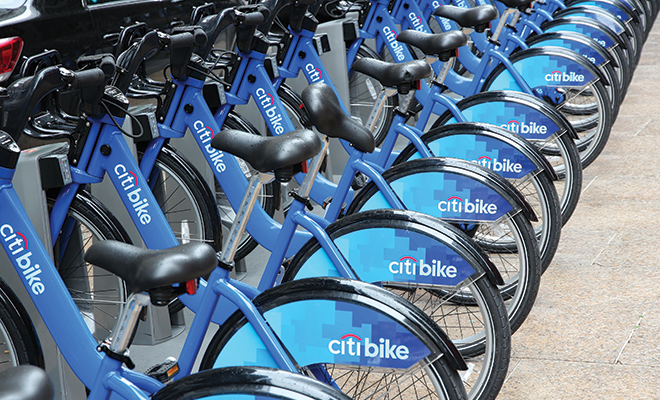
Bringing back biking
When was the last time you rode a bike? There’s nothing quite like it, with the cool breeze, scenery whizzing by as your feet pedal you toward your destination. If you live in a congested city, you may be hard-pressed to remember—unless your city has jumped on the bike-sharing bandwagon.
Biking has seen a surge in popularity over the last few years; it’s become an increasingly common mode of transportation for people in cities across the country as they look to save money, cut back on their carbon footprint or seek to live a more active lifestyle. This trend, combined with sharing economy models we’ve seen in companies such as Uber, Airbnb and others have led to bike-sharing programs popping up across the country. Many cities, including Minneapolis, Denver, Chicago, San Antonio and New York City, have adopted bike-sharing programs to cater to those who don’t own a bike but still want to enjoy the benefits of biking.
The basics
Bike-sharing programs can take many different forms. Municipal bike-sharing programs are funded by local jurisdictions such as cities or counties and are becoming increasingly common. Colleges and universities can implement their own programs, and private, for-profit bike-sharing companies are popping up as well, mostly on the campuses of large corporations such as Google and Facebook, according to the Commercial Real Estate Development Association.
Whether the programs are privately owned or run through a municipality, they generally follow the bike corral or docking station format. Stations with bikes for rent are set up throughout the area and anyone can borrow a bike through the purchase of either memberships or timed rentals. Bikes can be picked up and returned at any corral throughout the city. As San Antonio’s bike-share system, BCycle, explains on its website, the docking station system is convenient in that it provides “a bike that’s there when you need it, and gone when you don’t.” There’s no more worrying about where you can lock up your bike; you can drop it off at a station close to your destination!
Effect on cities
The benefits of bike-sharing programs are numerous. With more people cycling there are fewer cars on the road, reducing traffic congestion and harmful carbon emissions from engines. Divvy, Chicago’s bike-share system, had more than 750,000 trips in its first year. Each of those 750,000 trips meant there was one less person riding in a car or bus. There are obvious physical benefits as well; having bikes available at a moment’s notice promotes physical activity for people of all ages. If the program is municipally owned, it becomes a source of revenue that can be put back into the community. Finally, biking is more cost efficient than owning a car, with an annual cost comparable to that of monthly public transportation passes, which explains its popularity with young people who are just starting out in their careers.
Tips and tricks
Safety should always be top of mind when bikes are involved. The Huffington Post notes that crashes are increasing with the rise in popularity of these programs. Having more bikes on the road means that cities must adapt in order to accommodate and increase safety measures for cars and bikes alike, which is leading to more bike- and pedestrian-friendly cities. While many cities have already added safer bike lanes to major roads, it’s important to be aware of your surroundings at all times, whether you’re the one on the bike or in the car. Wear appropriate safety gear and clothing to prevent injuries in case of a fall or an accident.
The U.S. has 2,655 bike-share stations in 65 cities, according to the U.S. Department of Transportation. If your city has a bike-sharing system, you’ll want to be prepared before you put your feet on the pedals. Check your city’s bike-sharing program website to see if it offers helmet rentals. While renting a helmet is sometimes an option, it may be more cost effective to buy your own if you plan on biking regularly. You should also keep in mind that there may be overtime fees, so read the fine print and keep your eye on the clock. Follow the rules of the road to avoid any dangerous situations. Finally, you should plan your route ahead of time so you can be sure to find a nearby station to drop the bike off when you’re done, if you’re not biking round-trip.
With bike-sharing programs popping up across the country, you’re sure to see one in your city soon if you haven’t already. Try it out for a fun weekend activity or make it a part of your daily commute. With benefits such as reduced carbon emissions, lessened traffic congestion and more encouragement toward active lifestyles, there’s no reason not to try out this mode of transportation. HLM
Sources: divvybikes.com, huffingtonpost.com, www.naiop.org, rita.dot.gov, sanantonio.bcycle.com and usatoday.com.







